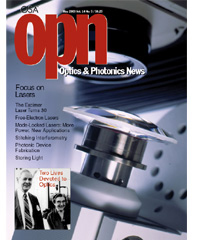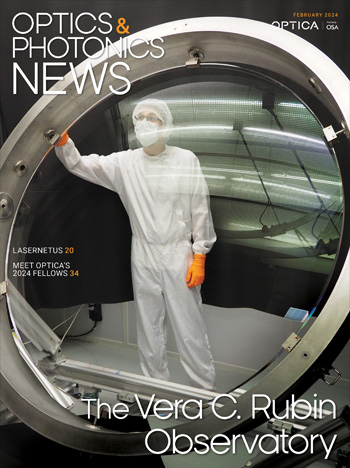
May 2003 Issue
Feature Articles
Free-Electron Lasers Push Into New Frontiers
The promise of high power and short wavelengths has tantalized scientists since the early days of free electron lasers (FELs). Developments in accelerator technologies and discoveries about the physics of FELs have allowed researchers to push performance into new frontiers.
by Stephen V. BensonExcimer Lasers at 30 Years
Thanks to research and development over the course of three decades, the excimer has become the laser of choice for many applications in the ultraviolet spectral region, including vision correction surgery and the photolithographic production of computer chips.
by J. J. EwingBright Storage of Light
Although for many years scientists have been aware of the ease with which optical images can be stored in transparent media, the idea of storing raw energy in optical form is quite new. The author describes the direct generation of stationary light by electrical means and some implications for dynamic electromagnetic energy storage.
by Stephen C. RandStitching Interferometry: A Flexible Solution for Surface Metrology
The fabrication of large high-quality optics continues to be a challenge, in part because of the difficulty of measuring extensive surface areas. One alternative is to measure many subapertures of the surface and “stitch” the results together to synthesize a full aperture map.
by Paul Murphy, Greg Forbes, Jon Fleig, Paul Dumas and Marc TricardPhotonic Device Fabrication With Femtosecond Laser Oscillators
With Femtosecond Laser Oscillators High-repetition-rate femtosecond laser oscillators are powerful tools for device fabrication. Today, waveguides can be written at speeds much higher than those that are possible using femtosecond amplifiers.
by Kaoru Minoshima, Andrew M. Kowalevicz, Ingmar Hartl, Erich P. Ippen and James G. FujimotoEver Higher Power From Mode-Locked Lasers
Passive mode locking was first used to generate ultrashort pulses in the mid-1960s. Today, mode locked lasers can generate pulses on the order of 5 fs at 60 W, a level of performance that allows researchers to target new applications.
by Rüdiger Paschotta and Ursula KellerDepartments and Columns
President's Science Budget Smaller than It Appears
If you listened to Bush administration officials present their 2004 budget proposals in early February, you might have concluded that science was in for a big boost in federal financial support. But the budget's figures may not match the language used to describe it.
Who's Who on the OSA Board of Directors
OPN talks with Vasudevan Lakshminarayanan.
The Early Days of Lasers
A professor from the University of Oxford recalls a small piece of laser history: his early research to disprove a 1959 claim that Russian researchers had detected optical gain in discharge-excited mercury-vapor-hydrogen mixtures.

![A multiplexed image of a human tonsil acquired. [NIAID] using the iterative bleaching extends multiplexity (IBEX) method.](https://opnmedia.blob.core.windows.net/$web/opn/media/images/articles/2024/0424/departments/202404-cover-web.jpg?ext=.jpg)

